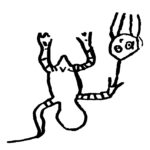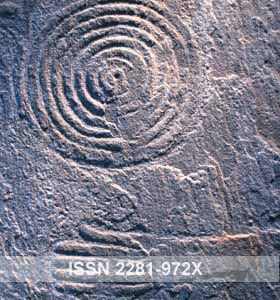 This short note discusses a possible addition of a “Trophy” Head petroglyph at Toro Muerto, southern Peru. Toro Muerto has the biggest concentration of “Trophy” Head petroglyphs in the Desert Andes. This paper suggests that another example can be added to the grand total, but simultaneously proposes that this new (possible) find – and many other panels at Toro Muerto – should be photographed in optimal circumstances to ascertain its identification.
This short note discusses a possible addition of a “Trophy” Head petroglyph at Toro Muerto, southern Peru. Toro Muerto has the biggest concentration of “Trophy” Head petroglyphs in the Desert Andes. This paper suggests that another example can be added to the grand total, but simultaneously proposes that this new (possible) find – and many other panels at Toro Muerto – should be photographed in optimal circumstances to ascertain its identification.
By Maarten van Hoek
*
*
“Trophy” Head # 42 at Toro Muerto?
*
Maarten van Hoek
Introduction
In 2023 I published a book about “Trophy” Heads in the Americas, also focussing on the petroglyphs involving “Trophy” Heads at Toro Muerto, southern Peru (Van Hoek 2023). It proves that Toro Muerto is undoubtedly the rock art site with the biggest number of “Trophy” Heads in both North and South America. No less than (a minimum of) 41 examples have been recognised by me (up to June 2023) and undoubtedly there are several more that have not yet been discovered, recognised and/or published. This short paper aims at adding an earlier recorded petroglyph at Toro Muerto, which was recognised by me as a possible image of a “Trophy” Head (hence the “?” in the title) , bringing the total to 42 (March 2024).
The panel in question was recorded in 2015 by Karolina Juszczyk and her team of the Proyecto Arqueológico Toro Muerto (up to 2017: PTM), a Polish-Peruvian surveying project. Unfortunately, the search-machine (buscar) in the Data Base published at the PTM-website (URL) does not include the term “trofeo”: No hay resultados que cumplan los criterios de búsqueda!). Yet petroglyphs of “Trophy” Heads appear in the photographs published by the PTM Data Base, but in some instances they are not even recognised as “Trophy” Heads (for instance the scene on Boulder PTM-1165 has not been recognised by them as two birds “disputing” a “Trophy” Head (the scene should have been included as “antropomorfos” and “aves”; see Van Hoek 2010: Fig. 33; Van Hoek 2023: Fig. 76). Finally, it is a pity that – after Mrs Karolina Juszczyk was “replaced” by her successor – the results of the Proyecto de Investigación Arqueológica Toro Muerto (after 2017: PIA-TM) (covering a smaller part in the north of the Toro Muerto boulder field) have not (yet?) been shared on the internet.
*
The Panel
The panel that I would like to discuss roughly faces SE (towards the Majes Valley) and has several petroglyphs that – because of the rather rough surface – are hard to distinguish. The panel is found somewhere in the centre of the boulder field. The exact location of this panel will not be revealed by me, also because the boulder has already been vandalised (contact me to be informed about the location of the panel).
Importantly, the Data Base of the PTM (2015) seems to claim that there is only one (? – PTM never provide numbers) petroglyph on the panel only depicting “camelidos”, but definitely no “antropomorfos”. In my opinion, every petroglyph of a “Trophy” Head should at least be classified as “antropomorfos”, but preferably it should be labelled as a separate classification, like “Cabeza Trofeo”. For instance, on Boulder PTM-1162 a distinct “Trophy” Head petroglyph (see Van Hoek 2010: Fig. 37) has not been labelled as a “Trophy” Head by the PTM-team. At least it should have been included as “antropomorfos” in their Data Base. To demonstrate that the panel may well have an image of a “Trophy” Head, I will first provide a photograph of the panel (Figure 1) and then I will compare it with my drawing of the scene (Figure 2).
Figure 1. The petroglyphs on the panel at Toro Muerto, southern Peru. Photograph © by the Proyecto Arqueológico Toro Muerto (PTM-2015), courtesy Karolina Juszczyk.
Figure 2. The petroglyphs on the panel at Toro Muerto, southern Peru. Drawing © by Maarten van Hoek, superimposed on the PTM-photo of Figure 1.
*
Discussion
As you can see in Figure 2, all my interpretations of the petroglyphs are questionable (hence the “??”). Because of the rough surface (and the slightly unfavourable light), it was impossible to create a drawing that was unfailing. Therefore, my superimposed drawings only serve to indicate where the purported “Trophy” Head is positioned on the panel. The purported “Trophy” Head might be carried by a bird. But that interpretation is also most uncertain. To the left of the purported “Trophy” Head is the possible image of a feline (recognisable by its long, downward curving tail). The other (orange) petroglyphs are even more problematic. This panel (that I did not inspect myself) needs a careful scientific scanning in order to reveal the exact layout of the petroglyphs, but I leave that to the experts (often having advanced technology to discover the correct layout of such “hidden” images).
It is however a fact that both felines and birds are often associated with “Trophy” Heads, not only at Toro Muerto, but also at other sites in the Majes Rock Art Style (the area between the Caravelí River in the west and the Vítor Drainage in the east; an area of about 200 by 100 km). Therefore, my very careful suggestion regarding the purported scene on the panel (Figure 2) is not farfetched. It is only not (yet) confirmed by verifiable photography. I hope that someone will someday inspect this panel in better lighting in order to ascertain what prehistoric people have really manufactured on the panel. And if my suggestion is correct, then the (minimum) number of “Trophy” Head petroglyphs at Toro Muerto will indeed reach 42.
*
Acknowledgement
I am grateful to Karolina Juszczyk for her kind permission to publish all (photographic) material of the Proyecto Arqueológico Toro Muerto (PTM-2015-2017).
*
References
Van Hoek, M. 2010. ‘Trophy’ heads in the rock art of the Majes Valley, Perú: exploring their possible origin. In: Rupestreweb.
Van Hoek. M. 2023. “Trophy” Heads in the Rock Art of North and South America”. Book available as PDF only at ResearchGate.
*
















Leave a Reply